Guru Shivarudra Parents Suryaji, Ranu-Bai Thosar Books Dasbodh | Role Poet Name Samarth Ramdas | |
 | ||
Died February 2, 1681, Sajjangad, Satara district Full name Narayan Suryajipant Kulkarni Thosar Similar Tukaram, Eknath, Swami Samarth | ||
Full shri manache shlok with lyrics shlok 1 205 samarth ramdas
Ramdas (Marathi language: Rāmdās) was a noted 17th-century brahmin saint and spiritual poet of Maharashtra. He is most remembered for his Advaita Vedantist text, the Dasbodh. Ramdas was a devotee of Hanuman and Rama.
Contents
- Full shri manache shlok with lyrics shlok 1 205 samarth ramdas
- Samartha Ramdas Swami Sumeet Music Marathi Movie
- Early life
- Pilgrimage and movement
- Sikh Guru Hargobind
- Work
- Chatrapati Sambhaji Maharaj and Ramdas
- Writings
- Samarth Sect
- Residences
- Death
- Disciples
- References
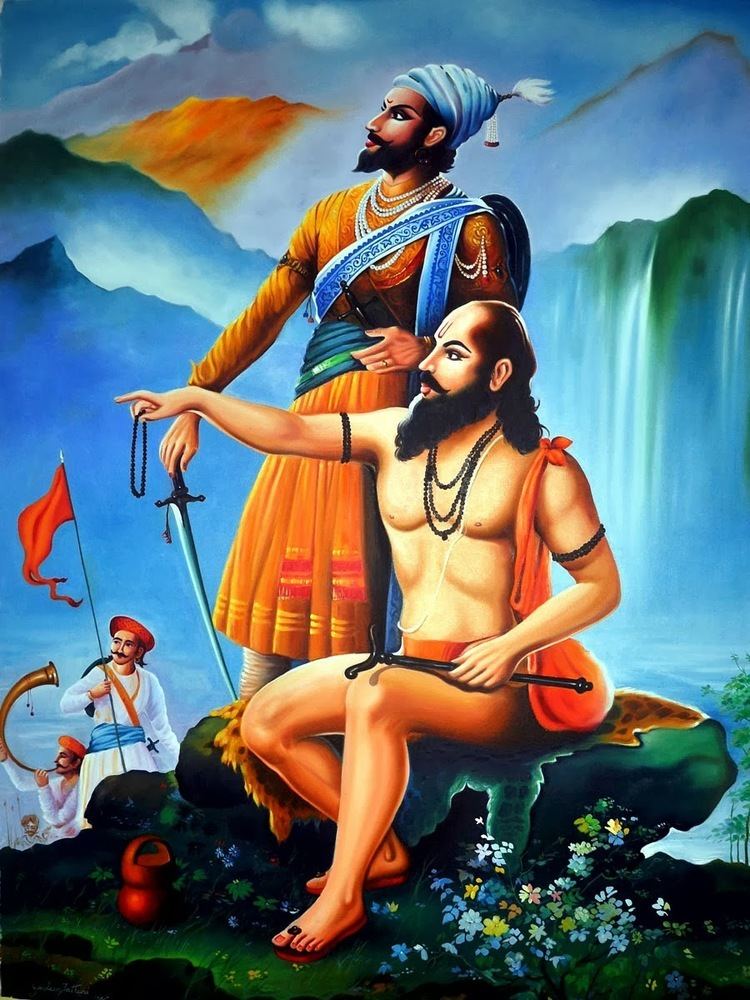
Samartha Ramdas Swami - Sumeet Music - Marathi Movie
Early life

The birth name of Samartha Ramdas Swami was Narayan Suryaji Thosar. He was born on Ramnavami (in the month of Chaitra) in 1530 (Shalivahana era), 1608 CE, in Jamb village, Ambad taluk, Jalna district, on the banks of the river Godavari in Deshastha Rugvedi brahmin family of Jamadagni Goatra. His parents were Suryaji Pant and Ranubai; his elder brother was Gangadhar Swami. His family, for many generations, were worshippers of Surya (Sun) and Ram.
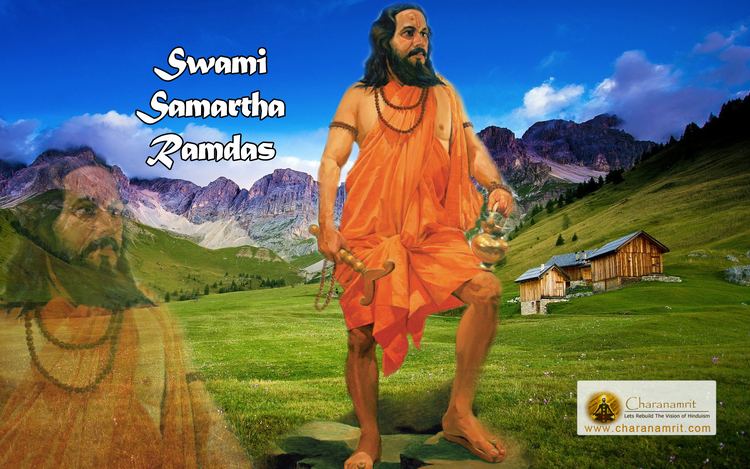
His father died when Ramdas was eight, turning him into an introvert. He was engrossed in thoughts of God and tried to find out how to meet God. At age 12 Ram appeared to him and advised him to count the 13 lettered Ram tarak Mantra 108 times at least once a day. Then Ram accepted him as his disciple, naming him Ramdas.

At 11, he attained enlightenment and advised by Lord Ram, started new sector on the banks of the river Krishna.
At 12, while he was standing on the podium during his marriage ceremony he heard the Brahmins chanting wedding mantras that included the word “Savadhan". This word has other meanings, including "Beware”! Immediately after hearing it he knew what it meant, fled the scene and went to the holy city, Nasik, where he started his worship of Ram, which lasted for 12 years.
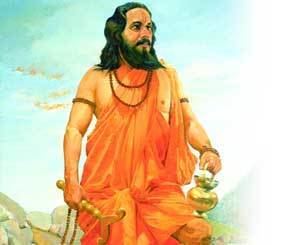
During childhood Narayan was fond of vigorous physical activity. He loved to exercise and was well built and intelligent. He was a firm believer of God and stood by his principles. His persona shone with devotion for Hanuman and Ram. He felt compassion for the common people. From his childhood he was thinking about how to relieve the masses. Marriage and family were not his priorities, preferring the life of a monk.
Pilgrimage and movement
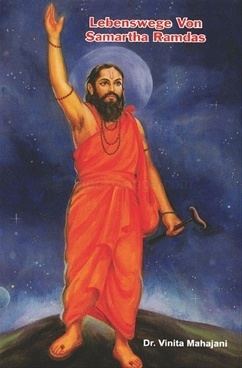
In 1554 (Shalivahana era) or 1632 CE, he left Takli to start his spiritual journey and his movement. He journeyed for 12 years throughout India, observing the people. The frequent floods and famines and the wanton and indiscriminate attacks by Muslim rulers, had destroyed society. Based on these experiences he wrote two books, Asmani Sultani and Parachakraniroopan, detailing his observations. These are the only two books in Indian Saint literature that record the conditions of those times.
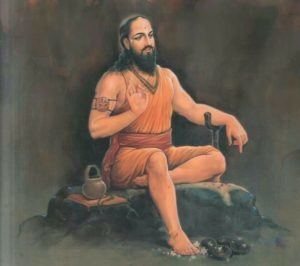
During Shree Samarth’s period outsiders were ruling India. The repercussions of their authoritarian rule were devastating. The Indians themselves were following in their footsteps for petty gains and regime opponents were executed. The Brahmans and the warrior caste had joined with the foreign rulers, while the traders worked with the bureaucrats to further their business. Shree Samarth was very much distressed with the plight of the people and decided to do what he could to succor the people.samartha also had a follower named kalyan who helped to write manache shlok
Ramdas got Darśana from Shree Dattatreya in Mahurgad.
Sikh Guru Hargobind
According to Sikh tradition based on an old Punjabi manuscript Panjah Sakhian, Ramdas met Guru Hargobind (1595-1644) at Srinagar in the Garhval hills. The meeting, corroborated in a 1793 Marathi source, Ramdas Swami`s Bakhar, by Hanumant Swami, probably took place in the early 1630s during Ramdas`s pilgrimage travels in the north and Guru Hargobind`s journey to Nanakmata in the east. It is said that as they met, Hargobind had just returned from a hunting excursion.
"I had heard that you occupied the Gaddi of Guru Nanak", said Swami Ramdas.
"Guru Nanak was a Tyagi sadhu - a saint who had renounced the world. You are wearing arms and keeping an army and horses. You allow yourself to be addressed as Sacha Patshah, the True King. What sort of a sadhu are you?" asked the Maratha saint.
Guru Hargobind replied, "Internally a hermit, and externally a prince. Arms mean protection to the poor and destruction of the tyrant. Baba Nanak had not renounced the world but had renounced Maya, i.e. self and ego:
"batan faquiri, zahir amiri, shastar garib ki rakhya, jarwan ki bhakhiya, Baba Nanak sansar nahi tyagya, Maya tyagi thi."
These words of Guru Hargobind found a ready response in Ramdas who, as quoted in Pothi Panjak Sakhian, spontaneously said, "this appealeth to my mind - Yeh hamare man bhavti hai"
Work
After finishing the pilgrimage he returned to Mahabaleshwar. Then, at Masur, he celebrated the jayanti of Lord Ram with thousands of others. He gathered people to advance his ultimate goal of returning the Hindu religion to its original form after its decline during hundreds of years of Muslim rule. He later found statues of Lord Ram in the river Krishna near Angapur. Ramdas chose the village of Chafal and initiated his mission in 1566 (Shalivahana era), or 1644 AD. He installed a statue of Lord Ram and started celebrating the festival of 'Birth of Lord Ram' (Ram Janmotsava) with fanfare.
He built a temple at Chafal and installed Lord Ram's Murti ceremoniously according to the Hindu tradition. He celebrated the birth day of Lord Ram that year at the newly built temple. He also established a temple of the Goddess Pratap Durga at the Pratapgad Fort.
His teaching of courage, patience and faith in the face of adversity helped people.
He chose Hanuman, who was extremely strong and valiantly faced enemies and emerged victorious, as a role model for the common man to combat murderous opponents. Lord Ram, the great archer, who killed Ravana and helped the Gods who were captured by him, was another role model. He felt that their personalities and characteristics would be ideal for the masses.
He established temples of Hanuman in towns and villages and preached the message of exercising regularly for strength. Out of hundreds of these Hanuman temples 11 are specially mentioned by him as 11 Maruti.
The Hanuman Temples established by him are found in most of the part of India such as Jaipur in Rajasthan, Varanasi in Uttar Pradesh, Tanjore in Tamil Nadu and Ujjain in Madhya Pradesh.
On reaching Tanjavar, he was received by Vyankojiraje, the brother of Shree Shivaji Maharaj, the King of Tanjavar. Shree Samarth accepted him as his disciple. At Tanjavar, revered religious figure Pundit Raghunath became his disciple.
Tanjaore math was the first one established by him when he came to south India for Sethu Himachal Padayatra. Ramdas saw that picture in his lifetime, contrary to the tradition of those days. Many special stories of him are there.
He taught the youth to band together to combat despots and plunderers. He stressed the importance of both strength and knowledge, insisting that the weak could not bring about change.
He said that the lazy would feel good temporarily, but that hard working individuals would stay happy.
He highlighted the warriors' role of establishing the rule of righteousness (dharma) in running society. He gave their duty towards society and martyrdom the utmost importance.
He stressed the primary importance of looking after the family's needs and that societal demands were secondary.
Ramdas established study centers across India, teaching his path. These created many disciples and followers.
He encouraged women to participate in religious work and gave them positions of authority. He had 18 female disciples. Vennabai managed the study center at Miraj and Akkabai at Chafal and Sajjangad. He once reprimanded an old man who was against women's participation in religious affairs by saying that everyone came from a woman's womb and those who did not understand the importance of this were unworthy of being called men. He said that respecting the role of women and giving them equal status was good for the growth of a healthy society.
He abhorred distinctions based on caste and creed, preaching that all human beings were equal. He stood for the abolition of social classes and for the promotion of worship.
During his last years, Ramdas told his disciples, "Even if my body will not be with you, I will always remain near you through my books which will guide you in every situation".
Chatrapati Sambhaji Maharaj and Ramdas
Chatrapati Sambhaji was a devout Hindu, but respected all religions within the region. He had great respect for all contemporary saints. Chatrapati Shivaji Maharaj's son Sambhaji Maharaj later built a samadhi temple for Ramdas Swami on Sajjangad upon the latter's death. Samarth Ramdas had also written a letter to Sambhaji Maharaj guiding him on what to do and what not to do after death of Chatrapati Shivaji Maharaj.
Writings
Shree Samarth produced volumes of output. These include a condensed version of the Dasbodha, Karunashtakas, Sunderkand and the Yuddhakand of the epic Ramayana, many Abhangas and Owis, Poorvarambh, Antarbhav, Atmaram, Chaturthman, Panchman, Manpanchak, Janaswabhawgosavi, Panchsamasi, Saptsamasi, Sagundhyan, Nirgundhyan, Junatpurush, Shadripunirupan, Panchikaranyog, Manache Shlok, Shreemat Dasbodha and many unpublished works.
His writing was so simple that illiterates understood it if read aloud to them. He took a straightforward, forceful and unhesitating approach. He used to write or dictate quickly and used Hindi, Urdu, Arabic or Sanskrit words so long as his writing remained simple. He introduced new words to these languages. Many of his sentences have become widely used the Marathi language.
He produced considerable literature in verse form in Marathi.
His most popular composition is the Marathi Aarti to Lord Ganesh Sukhakarta Dukhaharta. He also composed several other Aartis such as Satrane Uddane Hunkaar Vadani to Lord Hanuman and Panchanan haivahan surabhushan lila to Lord Khandoba. He has written Aarti of almost all Gods. His most famous work, Dasbodh has been translated into most of the prominent Indian languages. The original copy of Dasbodh, scribed by his disciple, is in the Domgaon Mutt.
Samarth Sect
He started the Shree Samarth religious sect to work for the liberation of India and for the renewal of true spirituality. His followers were neophytes who had not been corrupted by politics. He supported King Shivaji, who was trying to overthrow the Muslim rulers.
He established Math (Holy places where like minded religious people could reside and work) at many locations. He chose leaders of the maths who were multifaceted, spiritual, set high moral standards and were able to work for the society and were politically adept.
Samarth was of the opinion that saints who sit quietly in the midst of suffering were a shame on mankind and unfit to be saints. He proclaimed this to the heads of the Math. He thereby blended spirituality, social work and politics. In the end, his movement was successful.
Residences
Ramdas moved around quite a lot and used several Ghal (Marathi: घळ), small caves used for meditation. The famous ones include:
Ramdas established Aadya Chafal Math first and then in year 1648 founded Shree Ram Mandir, Das Maruti Mandir and Veer Maruti Mandir.
Death
Ramdas died on the ninth day of Magh, 1603 (Shalivahana era), 1681 CE at Sajjangad at age 73. For five days prior to this he had ceased eating fruits and drinking water called as "Prayopaveshana". He was continuously chanting the taraka mantra "Shriram Jay Ram Jay Jay Ram" in front of Ram's Murti which was brought from Tanjore. Uddhav Swami and Akka Swami were in his service.
The funeral was performed by Uddhav Swami. The Samadhi shrine was built by Chatrapati Sambhaji Maharaj.
Disciples
Samarth Ramdas had many disciples. Kalyan Swami worked as a writer for Ramdas, recording his songs and prayers. Ramdas tested him in many ways before giving him this responsible position. Other noteworthy disciples included
In the 20th century, prominent figures such as Lokmanya Bal Gangadhar Tilak, Keshav Baliram Hedgevar, and Gurudev Ranade drew inspiration from his teachings. His philosophy continues to influence both spiritual and social leaders. Nana Dharmadhikari was instrumental in promoting Ramdas' teachings. The text "Dasbodh" was notably used by Bhausaheb Maharaj, founder of the Inchegeri Sampradaya, to educate his disciples. Additionally, "Dasbodh" has been translated and published by American adherents of Ranjit Maharaj, who also was a member of the Inchegeri Sampradaya.
